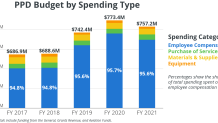The Philadelphia police department is failing to consider the people it serves when allocating its annual budget and making personnel decisions, according to a report released Tuesday by the City Controller's office.
The report, two years in the making, looked at how the police department constructs its budget -- which topped $750 million last year -- and how the 6,000 uniformed officers are deployed throughout the city. Philadelphia spends the fifth most per capita on policing of all large American cities, according to the report.
"The review found that PPD’s budget is not developed with involvement and input from the communities it serves but rather, its budget is generally based on historical spending levels, including headcounts and the perceived needs of different units and programs," the controller's report said. "This results in a budget that is neither strategically developed nor responsive to or aligned with the voiced concerns and needs of Philadelphians."
"Additionally, it does not appear that PPD performs any analysis to identify how many positions (officers or civilians) or hours are required each year to meet its public safety goals, hindering PPD’s ability to determine the total number of positions needed to respond to the needs of the community," the report also said.
Get Philly local news, weather forecasts, sports and entertainment stories to your inbox. Sign up for NBC Philadelphia newsletters.
The department is hampered in its decision-making, compared to other big cities, by the amount of its budget locked into personnel costs, the report found. At more than 95% of budget costs dedicated to salaries and benefits, the Philadelphia police department spends the largest percentage of any large city in the United States.

About 2,500 of the 6,000 sworn officers on the force are assigned to patrol units, according to the report, or about 42%. Meanwhile, the total number of officers has fallen by 500 in the last three years and 572 officers every day on average are out for being "injured on duty."
Local
Breaking news and the stories that matter to your neighborhood.
Retention and recruitment continue to be problems for the department, and the sworn officer count could fall to 5,200 by 2025 if the current annual decreases continue.
The report also found a disparity in police response times in Philadelphia’s Black and Brown communities in comparison to the city’s predominantly white neighborhoods.
“The analysis also reviewed response times by district, finding the police districts that experienced the longest dispatch response times are concentrated in the city’s Black and Brown communities,” the report said. “Districts with more white residents received faster response times overall, with the districts with the highest concentration of white residents experiencing dispatch response times more than twice as fast as those districts with majority Black and Brown Philadelphians.”
City Controller Rebecca Rhynhart spoke on the disparity during her press conference on Tuesday.
“The report did not find why the disparity existed in response times,” Rhynhart said. “It just found that it did and it needs to be evaluated.”
The report issued many recommendations for improvement both in spending and personnel, including:
- Building an annual budget "centered on the communicated needs of the communities it serves and should determine its personnel and programmatic requirements based on the needs of the community."
- Improving the "the accuracy and consistency of the data collected and tracked related to (injured on duty) and leave usage, including the Heart and Lung benefit."
- Developing "continual monitoring systems and community feedback mechanisms to ensure staffing and deployment of officers in each district is adequate for, and informed by, the evolving needs of the community."
- Updating its systems and processes to reduce inefficiencies and redundancies, like eliminating unnecessary paper processes" that require manpower better used elsewhere.
- Finishing the "distribution of body-worn cameras and broaden the usage of footage collected by the cameras."
The report concluded that the "PPD’s reliance on historical budgeting, staffing, and resource allocation practices, as well as its use of outdated technology and processes, limits its ability to be informed about and strategically respond to the varied needs of communities across the city. The findings and recommendations in this report represent an important opportunity to not only improve public safety outcomes but also to build legitimacy and trust with Philadelphia communities through an ongoing dialogue with the public about community concerns and potential solutions to address them. These concerns and possible solutions should directly inform what resources police need and how police invest time, money, and resources."
To view the full report, CLICK HERE.



